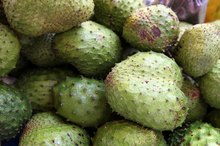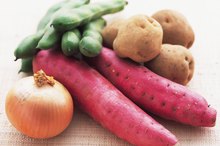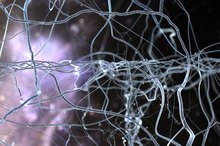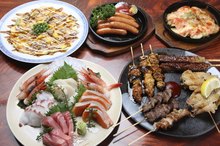What Food or Fruit Contains Serotonin?
Serotonin is an important chemical in your body that is responsible for a number of physiological functions and brain processes, such as mood and sleeping. Along with dopamine and norepinephrine, it is chemically categorized as a monoamine neurotransmitter. Serotonin is generated in your body by enzymes that metabolize the amino acid tryptophan, which is an essential amino acid, because your body requires a diet that contains this amino acid. Similar to tryptophan, certain foods contain high levels of serotonin.
If you are experiencing serious medical symptoms, seek emergency treatment immediately.
Fruits
Fruits are among the types of food that have the highest serotonin content according to a study published in the October 1985 of "American Journal of Clinical Nutrition." Using an analysis technique called a radioenzymatic assay, researchers reported that plantains, pineapples, bananas, kiwi fruit and plums have high serotonin contents. For example, plantains contain on average 30 micrograms of serotonin per gram of the fruit. Pineapples contain 17 micrograms and bananas contain 15 micrograms of serotonin per gram of the fruit.
- Fruits are among the types of food that have the highest serotonin content according to a study published in the October 1985 of "American Journal of Clinical Nutrition."
- Using an analysis technique called a radioenzymatic assay, researchers reported that plantains, pineapples, bananas, kiwi fruit and plums have high serotonin contents.
Vegetables
Dopamine Lowering Herbs
Learn More
Vegetables are also an excellent source of serotonin 3. In a study published in “Journal of Medicinal Food, ” researchers used an analysis technique called high performance liquid chromatography, which showed that among vegetables, tomatoes contain one of the highest levels of serotonin at 221 micrograms per gram of the tomato. Cherry tomatoes, spinach, Chinese cabbage and hot peppers also contained significant levels of serotonin. However, the serotonin content of vegetables is generally lower than that of fruits.
- Vegetables are also an excellent source of serotonin 3.
- However, the serotonin content of vegetables is generally lower than that of fruits.
Nuts
In addition to fruits and vegetables, there are also significant serotonin levels found in nuts. In particular, nuts from the walnut family have very high levels of serotonin. For example, butternuts have 398 micrograms of serotonin per gram of the nut, black walnuts have 304 micrograms of serotonin per gram of the nut and English walnuts have 87 micrograms of serotonin per gram of the nut. Outside of the walnut family, pecans and sweet pignuts have high levels of serotonin at 29 and 25 micrograms per gram of the nut, respectively.
- In addition to fruits and vegetables, there are also significant serotonin levels found in nuts.
- Outside of the walnut family, pecans and sweet pignuts have high levels of serotonin at 29 and 25 micrograms per gram of the nut, respectively.
Other Foods
How to Use 5 HTP With Rhodiola Rosea to Keep Serotonin for the Brain
Learn More
Your body metabolizes serotonin from the amino acid tryptophan. As such, increasing your dietary intake of tryptophan allows your body to synthesize more serotonin. There are some foods that have high levels of tryptophan, and consuming these foods can increase serotonin levels in your body. According to the USDA, one large, hard-boiled egg contains .08 grams of tryptophan. Also according to the USDA, other foods that have high levels of tryptophan are soybeans, pumpkin seeds, Parmesan cheese, sesame seeds, cheddar cheese, turkey and chicken.
- Your body metabolizes serotonin from the amino acid tryptophan.
- As such, increasing your dietary intake of tryptophan allows your body to synthesize more serotonin.
Related Articles
References
- “The Biochemical Basis of Neuropharmacology”; JR Cooper, et al.; 2003
- “The American Journal of Clinical Nutrition”; Serotonin content of foods: effect on urinary excretion of 5-hydroxyindoleactic acid; Feldman, et al.; October 1985
- “Journal of Medicinal Food”; HPLC analysis of serotonin, tryptamine, tyramine, and the hydroxycinnamic acid amides of serotonin and tryamine in food vegetables; D. Ly, et al.; June 2008
- Frazer A, Hensler JG. Serotonin Involvement in Physiological Function and Behavior. In: Siegel GJ, Agranoff BW, Albers RW, et al., editors. Basic Neurochemistry: Molecular, Cellular and Medical Aspects. 6th edition. Philadelphia: Lippincott-Raven; 1999.
- Lv J, Liu F. The role of serotonin beyond the central nervous system during embryogenesis. Front Cell Neurosci. 2017;11. doi:10.3389/fncel.2017.00074
- Yano JM, Yu K, Donaldson GP, GG Shastri, P Ann, L Ma, et al. Indigenous bacteria from the gut microbiota regulate host serotonin biosynthesis [published correction appears in Cell. 2015 Sep 24;163:258]. Cell. 2015;161(2):264‐276. doi:10.1016/j.cell.2015.02.047
- Jenkins TA, Nguyen JC, Polglaze KE, Bertrand PP. Influence of tryptophan and serotonin on mood and cognition with a possible role of the gut-brain axis. Nutrients. 2016;8(1):56. doi:10.3390/nu8010056
- Lin SH, Lee LT, Yang YK. Serotonin and mental disorders: A concise review on molecular neuroimaging evidence. Clin Psychopharmacol Neurosci. 2014;12(3):196‐202. doi:10.9758/cpn.2014.12.3.196
- Mawe GM, Hoffman JM. Serotonin signalling in the gut--functions, dysfunctions and therapeutic targets [published correction appears in Nat Rev Gastroenterol Hepatol. 2013 Oct;10(10):564]. Nat Rev Gastroenterol Hepatol. 2013;10(8):473‐486. doi:10.1038/nrgastro.2013.105
- Banskota S, Ghia J-E, Khan WI. Serotonin in the gut: Blessing or a curse. Biochimie. 2019;161:56-64. doi:10.1016/j.biochi.2018.06.008
- Nakamaru-Ogiso E, Miyamoto H, Hamada K, Tsukada K, Takai K. Novel biochemical manipulation of brain serotonin reveals a role of serotonin in the circadian rhythm of sleep-wake cycles. Eur J Neurosci. 2012;35(11):1762‐1770. doi:10.1111/j.1460-9568.2012.08077.x
- Haduch A, Bromek E, Wojcikowski J, Golembiowska K, Daniel WA. Melatonin supports CYP2D-mediated serotonin synthesis in the brain. Drug Metabolism and Disposition. 2016;44(3):445-452. doi:10.1124/dmd.115.067413
- Carhart-Harris R, Nutt D. Serotonin and brain function: A tale of two receptors. J Psychopharmacol. 2017;31(9):1091-1120. doi:10.1177/0269881117725915
- de Abajo, FJ. Effects of selective serotonin reuptake inhibitors on platelet function. Drugs Aging. 2011;28:345-367. doi:10.2165/11589340-000000000-00000
- Sansone R, Sansone L. SSRIs: Bad to the bone?. Innovations in Clinical Neuroscience. 2012;9(7-8):42-47.
- Clayton AH, Alkis AR, Parikh NB, Votta JG. Sexual dysfunction due to psychotropic medications. Psychiatric Clinics of North America. 2016;39(3):427-463. doi:10.1016/j.psc.2016.04.006
- Croft HA. Understanding the role of serotonin in female hypoactive sexual desire disorder and treatment options. The Journal of Sexual Medicine. 2017;14(12):1575-1584. doi:10.1016/j.jsxm.2017.10.068
- Cowen PJ, Browning M. What has serotonin to do with depression?. World Psychiatry. 2015;14(2):158‐160. doi:10.1002/wps.20229
- What causes depression?. Harvard Health Publishing. Updated June 24, 2019.
- Wnuk, A. Rethinking serotonin’s role in depression. Society for Neuroscience. Updated March 2019.
- Harmer CJ, Duman RS, Cowen PJ. How do antidepressants work? New perspectives for refining future treatment approaches. Lancet Psychiatry. 2017;4(5):409‐418. doi:10.1016/S2215-0366(17)30015-9
- Cruz MP. Vilazodone HCl (Viibryd): A serotonin partial agonist and reuptake inhibitor for the treatment of major depressive disorder. PT. 2012;37(1):28‐31.
- DailyMed - TRINTELLIX- vortioxetine tablet, film coated. National Institutes of Health (NIH). Updated July 26, 2019.
- APA Dictionary of Psychology: Tricyclic antidepressant. American Psychological Association (APA). Updated 2014.
- Sub Laban T, Saadabadi A. Monoamine Oxidase Inhibitors (MAOI) [Updated 2020 Mar 26]. In: StatPearls [Internet]. Treasure Island (FL): StatPearls Publishing; 2020 Jan-.
- Jenkins TA, Nguyen JC, Polglaze KE, Bertrand PP. Influence of tryptophan and serotonin on mood and cognition with a possible role of the gut-brain axis. Nutrients. 2016;8(1):56. doi:10.3390/nu8010056
- Carpenter S. That gut feeling. American Psychiatric Association (APA). Updated September 2012.
- Sansone RA, Sansone LA. Sunshine, serotonin, and skin: a partial explanation for seasonal patterns in psychopathology?. Innov Clin Neurosci. 2013;10(7-8):20‐24.
- Heijnen S, Hommel B, Kibele A, Colzato LS. Neuromodulation of aerobic exercise: A review. Front Psychol. 2016;6:1890. doi:10.3389/fpsyg.2015.01890
- The U.S. Department of Health and Human Services, President’s Council on Sports, Fitness & Nutrition, Assistant Secretary for Health (ASH). Physical Activity Guidelines for Americans. Updated February 1, 2019.
- Field T, Hernandez-Reif M, Diego M, Schanberg S, Huhn C. Cortisol decreases and serotonin and dopamine increase following massage therapy. International Journal of Neuroscience. 2005;115(10):1397-1413. doi:10.1080/00207450590956459
- Hinz M, Stein A, Uncini T. Relative nutritional deficiencies associated with centrally acting monoamines [published correction appears in Int J Gen Med. 2015;8:163]. Int J Gen Med. 2012;5:413‐430. doi:10.2147/IJGM.S31179
- Wallace C, Milev R. The effects of probiotics on depressive symptoms in humans: A systematic review. Annals of General Psychiatry. 2017;16(14). doi:10.1186/s12991-017-0138-2
- Patel YA, Marzella N. Dietary supplement-drug interaction-induced serotonin syndrome progressing to acute compartment syndrome. Am J Case Rep. 2017;18:926‐930. doi:10.12659/ajcr.904375
- Ellis JG, Perlis ML, Bastien CH, Gardani M, Espie CA. The Natural History of Insomnia: Acute Insomnia and First-onset Depression. 2014;37(1):97-106. doi:10.5665/sleep.3316
- Gellynck E, Heyninck K, Andressen, KW, Haegeman G, Levy FO, Vanhoenacker P. The serotonin 5-HT7 receptors: two decades of research. Exp Brain Res 230, 555–568 (2013). doi:10.1007/s00221-013-3694-y
- Olivier B. Serotonin: A never-ending story. European Journal of Pharmacology. 2015;753:2-18. doi:10.1016/j.ejphar.2014.10.031
- Schuch FB, Vancampfort D, Richards J, Rosenbaum S, Ward PB, Stubbs B. Exercise as a treatment for depression: A meta-analysis adjusting for publication bias. Journal of Psychiatric Research. 2016;77:42-51. doi:10.1016/j.jpsychires.2016.02.023
- Voigt J-P, Fink H. Serotonin controlling feeding and satiety. Behavioural Brain Research. 2015;277:14-31. doi:10.1016/j.bbr.2014.08.065
Writer Bio
Kevin McInerney began writing professionally in 2006 and has written peer-reviewed scientific articles for respected research journals, such as the "Journal of Pharmacology" and "Experimental Therapeutics and Psychopharmacology." He has extensive experience with pharmacology, neuroscience, psychiatry and neurology. McInerney obtained a Ph.D. in neuroscience from Emory University.









